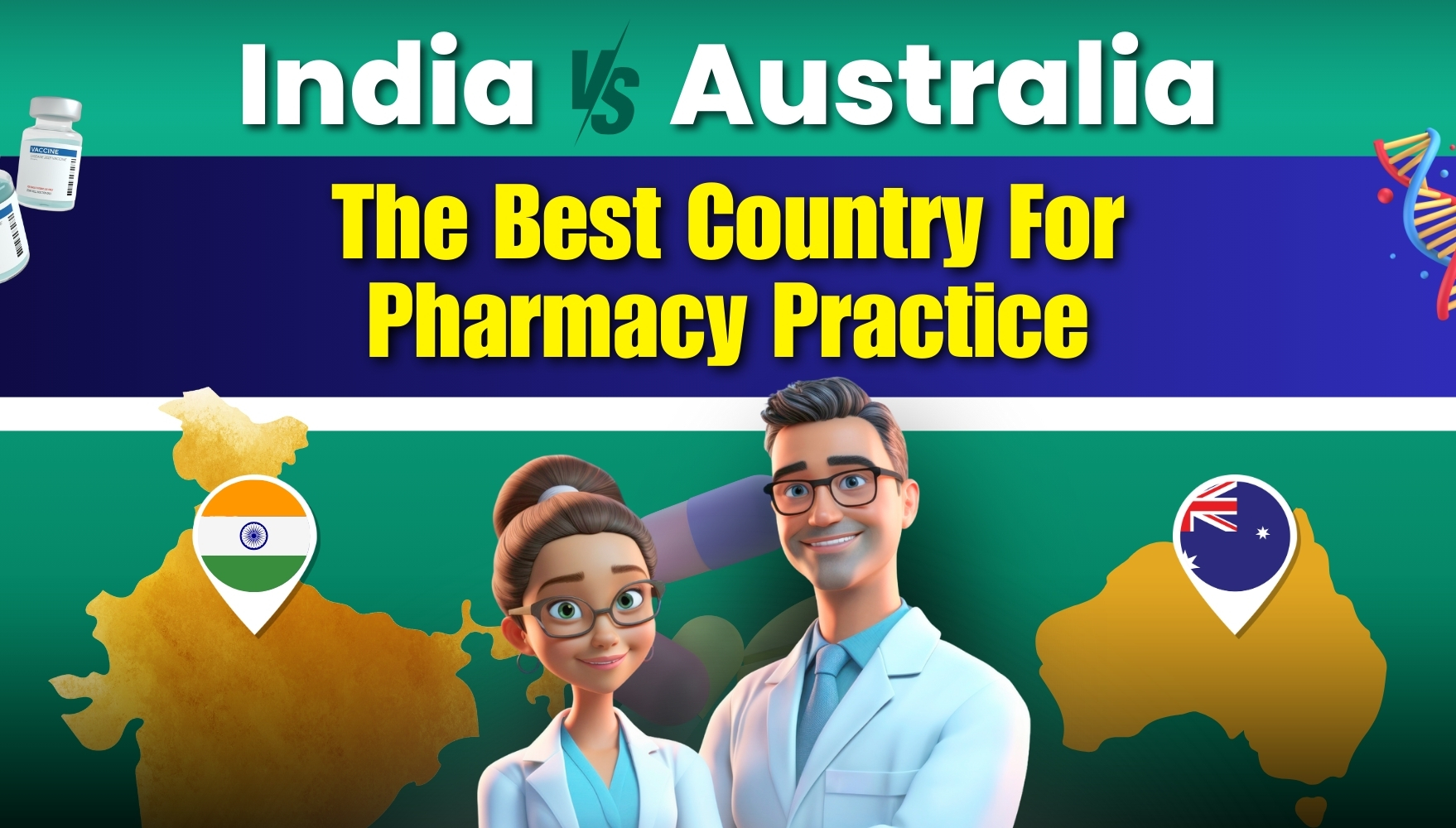What is Pharmacy Practice?
Before deciding to move anywhere, it is essential to understand what Pharmacy Practice entails. Pharmacy practice is every activity that a licensed pharmacist undertakes to provide the best healthcare to patients.
This includes a wide range of activities:
- Analysing prescriptions
- Dispensing medicines
- Patient Counselling
- Monitoring health outcomes of medicines
- Educating patients on drug interactions
- Maintaining medicine stock
A pharmacist should have the knowledge and skills to carry out these activities competently.
India vs Australia: A Comparative Study
Let us compare the basic requirements and fundamental aspects of pharmacy practice in India and Australia.
| Aspect | India | Australia |
| Education | BPharm/PharmD | BPharm/OPRA |
| Duration of study | 4 years/ 6 years | 4 years/ 3 years |
| Registration | ||
| Work | Less and competitive | High Demand |
| Salary | Less | High |
| Job Security | Variable | High |
| Work-Life Balance | Difficult | Comfortable |
| Cost of living | .Low | Compensated with a high salary |
| Career Growth | Less | More |
Hope that gave you the basic idea of the life of a pharmacist in the two countries. Let’s discuss these points in depth
Education
India
- Education Qualification: Bachelor of Pharmacy, Doctor of Pharmacy
- Curriculum: The bachelor’s syllabus is divided into 4 main subjects:
- Pharmaceutical Chemistry
- Pharmacognosy
- Pharmacology
- Pharmaceutics
PharmD covers all these subjects along with the clinical aspect. It also focuses on patient care and clinical practice.
- Duration of Study: The B.Pharm degree duration is 4 years.
PharmD is a 6-year course. It also includes a 1-year internship period.
- Challenges: The quality of education depends on the institute and varies. Regulatory standards are not uniformly enforced.
Australia
- Degrees: Bachelor of Pharmacy
- Requirement for Overseas Students: International graduates need to pass the Overseas Pharmacist Readiness Assessment (OPRA) Exam.
- Curriculum: The BPharm curriculum is extensive. It covers multiple topics such as:
- Pharmaceutical Sciences
- Clinical Pharmacy
- Pharmacy Practice
It also includes extensive practical training.
- Duration of Study: The B.Pharm course duration is 4 years.
An international pharmacist can typically complete the OPRA requirements within 3 years.
- Educational Institutions: Australia has globally recognized universities. They follow international education standards. Practical and clinical training are an integral part of pharmacy education.
- Advantages: Uniformly high educational standards and rigorous accreditation processes.
Work Environment
India
- Pharmacy Settings: Pharmacies in India are mostly independently owned or part of smaller chains.
Hospital and clinical pharmacies are also common.
- Regulations: Rules and regulations are not followed very strictly. This leads to variations in practice standards.
- Challenges: The population of India results in an exceptionally high number of patients. Handling such large numbers can be very hectic. It also results in extended work hours.
Australia
- Pharmacy Settings: Pharmacies are often part of large, well-organized chains. Or they are a part of hospital systems with standardised practices.
- Policies and Regulations: The regulations are strictly followed. Non-compliance can result in severe penalties. This ensures an effective healthcare service.
- Advantages: Work environments are well-organised. Pharmacists are provided with resources and support.
Salaries
India
- Average Pharmacist Salary: A pharmacist in India can earn an average of 2.5 lakh - 6 lakh rupees per year. This changes with experience and job role.
- Challenges: The salaries for pharmacists in India are relatively low. This is in spite of the high educational qualification and expenses.
Australia
- Average Pharmacist Salary: Australia is one of the top-paying countries for pharmacists. On average, a pharmacist can make 70,000-90,000 AUD annually.
- Advantages: Australia provides competitive salaries. This will increase with experience and specialized roles.
Work-Life Balance
India
- Challenges: Indian pharmacists work long hours. There is no uniformity in working hours. Some may even work on weekends and public holidays.
- Support: Limited support and high patient loads can add to stress levels.
Australia
- Advantages: Australia has a much better work-life balance. The laws regulate working hours. Extra hours are compensated handsomely.
- Flexibility: The working hours are flexible. Pharmacies have a routing system. This gives more time for part-time jobs.
Opportunities for Career Growth
India
- Opportunities: India has limited opportunities for pharmacists. Most of the opportunities are in larger cities only. There also, specialized roles are few. It can take years to climb up the career ladder.
- Challenges: Advancing your career requires not only hard work but also sacrificing personal time. Additional courses and certificates have become necessary to grow.
Australia
- Opportunities: The Australian Healthcare system provides excellent opportunities for career advancement. You can get into specialisation, management roles, and research positions.
- Support: Strong support for continuous professional development and advanced training.
Job Security
India
- Variable: Job security can be variable, with high competition and fewer job openings in some regions.
- Challenges: Economic and regulatory changes can impact job stability.
Australia
- Job Security: High job security due to the strong demand for pharmacists.
- Advantages: Stable job market with consistent demand for healthcare professionals
Cost of Living
India
- Lower Cost: The cost of living in India is much lower than in Australia. It is easier to manage daily expenses.
- Challenges: Although the cost of living is low, the salary is lower too. This means you are not left with much in savings. Additional expenses can also lead to a financial burden.
Australia
- Higher Cost: Australia has one of the highest living costs in the world. Major cities like Sydney and Melbourne are particularly expensive.
- Advantages: The high cost of living is compensated by the high salaries. You can lead a good quality of life on a pharmacist’s salary.
Final Thoughts
The decision to move countries for a career is not an easy one. You will not only have to consider a possible career, but also the sacrifices that are to be made.
India provides a familiar environment and affordable living.
What you gain in low cost of living, you have to sacrifice in career growth. Low salaries and a lack of specialized opportunities can hinder your career growth.
While Australia offers excellent career opportunities and high salaries, living in major cities can be expensive. People may also find living away from family difficult. Although for this, registered pharmacists have the option of PR and bringing their family to Australia.
If you are considering choosing Australia, you must pass the OPRA exam. Academically’s OPRA Exam Preparation Course is the best coaching you will get online.
The choice ultimately is yours to make. This blog has presented all the information you need to make this decision.




